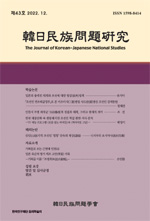한국 대중문화 속 관동대지진 조선인 학살 관련 서사 분석
An Analysis of the Korean Massacre in the Great Kanto Earthquake in Korean Popular Culture: TV entertainment programs “People Beyond the Line”, “History Journal That Day”
- 108

韓国の大衆文化で関東大震災時朝鮮人虐殺を取り扱うようになったのは、80年代の2本の演劇を除くと最近のことである。関東大震災の惨状や帝国日本に立ち向かう朝鮮人とこれに連帯した日本人の抵抗を盛り込んだ、映画<朴烈>(2017年)がそのきっかけである。2019年以降、MBC·KBS·SBSすべて、関東大震災時朝鮮人虐殺または朴烈をテーマにした芸能番組を制作した。 MBCは旅行·時事·教養が融合された芸能番組<ラインを超える人々>で取り扱った。日本·東京を訪れた出演者らは、「関東大虐殺」の現場である荒川の四ッ木橋を訪ねた。そこで2009年に立てられた追悼碑を紹介しながら、朝鮮人虐殺のが概略を説明し、追悼碑建立など関連活動を長年行った日本人と会って感謝を伝えた。18分という非常に短い時間にもかかわらず、「歴史を学ぶ旅行」番組らしく、虐殺の現場ともっとも最近立てられた追悼碑を直接訪ねてその碑文全体を紹介した点や、軍隊が虐殺に介入した事実を指摘したことは高く評価できる。しかし、虐殺に対する国家責任が「幇助」や「加担」という言葉で曖昧に表現されており、「良心的日本人」を強調したあまり、被虐殺者および関連の研究や活動を行った在日朝鮮人に対する視線が欠如している。日本の国家責任を究明し、この歴史を通じて「誰」を記憶すべきかを問う作業は、100年を控えている今、我々が朝鮮人虐殺の歴史を記憶し継承するのに核心であろう。 KBSは「インフォテインメント番組」、「歴史トークショー」として約10年間続いている<歴史ジャーナル、あの日>で取り扱った。<ラインを超える人々>では欠如していた在日朝鮮人の存在や役割が、俳優や監督(作品紹介)、研究者(インタビュー)を通じて紹介され、この問題を長年研究してきた歴史学者が出演したことによって、高い専門性を帯びている。関東大震災朝鮮人虐殺に対する背景や推移に合わせて、日本社会および政府のみならず、韓国政府とこの歴史をよく知らなかった韓国人自らに対する批判の意識を見せており、なお連帯や人権という普遍的価値を強調したことが特徴である。ただ、流言飛語や虐殺の背景には独立運動に対する警戒と朝鮮人に対する偏見や蔑視を意味する「不逞鮮人」イメージが日本社会に拡散していたこと、そして虐殺に対する大韓民国臨時政府をはじめとする国内外の朝鮮人が多様な抗議活動を展開したことは取り上げられなければならない。 両番組とも、歪曲や誤りとして指摘すべき内容もなく、日韓両国の政府の責任を明らかにし、追悼碑を通じて在日朝鮮人や日本市民の取り組みも伝えるなど、相当バランスの取れた高いレベルの内容となっている。したがって芸能番組として娯楽性まで求められる番組に対して、本稿で指摘した内容は過度かもしれない。また歴史学者が諮問や監修、出演を通じて、編集過程を経た放送内容より、もっと豊かで詳しい内容を伝えているかもしれない。にもかかわらず、上記のような「批評」や補完を要求したのは、一社会の歴史認識の形成や発展に大衆文化が占める位相や重要性、またそのなかの専門性を保証し牽引しなければならない学界の責任のためである。いま歴史学者らは、残された課題を研究し、大衆の歴史と疎通する「21世紀の実践的歴史学」を求められている。歴史歪曲や無関心を乗り越え、在日朝鮮人と日本の中のマイノリティ、中国との「記憶の連帯」を形成し、ともに東アジアの人権と和解を語ることのできる基盤をつくっていかなければならない。
With the exception of two plays in the 1980s, Korean popular culture has only recently begun to deal with the massacre of Koreans during the Great Kanto Earthquake. The impetus for this is the movie <Anarchist from Colony(Park Yeol)>(2017), about the devastation of the Great Kanto Earthquake, the resistance of the Koreans against Imperial Japan and the Japanese who joined forces with it. Since 2019, MBC, KBS, and SBS have all produced entertainment programs with the theme of the massacre of Koreans during the Great Kanto Earthquake or Park Yeol. MBC dealt with this topic in the entertainment program <People Beyond the Line>, which is a fusion of travel, current affairs, and culture. The performers visited the Yotsugi Bridge on the Arakawa River(Tokyo, Japan), the scene of the “Kanto Massacre”. They introduced the Memorial monument, which was established in 2009, explained the outline of the massacre of Koreans, and met with Japanese people who had been engaged in related activities for a long time, including the construction of the Memorial Stone, to express their gratitude. Despite the very short time of 18 minutes, it is highly appreciated, as a “travel to learn about history” program, that they visited the scene of the massacre and the most recent memorial monument, introduced the entire inscription and pointed out military intervention in the massacre. However, the Japaneset state's responsibility for the massacre was vaguely expressed as “assistance” and “complicity”, and there is a lack of perspective on the victims and Korean residents in Japan, who have been conducting related research and activities because of the excessive emphasis on “conscientious Japanese”. Finding out Japan's national responsibility and questioning “who” should be remembered through this history will be central to us remembering and succession of this history, now that we are approaching the 100th anniversary. KBS has dealt with 'History Journal, That Day', which has been running for about 10 years as an 'infotainment program' and 'history talk show'. In this program, the existence and role of Korean residents in Japan were introduced through actor, director(introduction of works), professor(interview), and the appearance of a historian who has studied this topic for a long time has increased the professionalism of this program. It is characterized by explaining the background and transition of the massacre of Koreans in the Great Kanto Earthquake, criticizing not only Japanese society and the government, but also the Korean government and the Koreans themselves, who were unaware of this history, and emphasizing the universal value of solidarity and human rights. However, it should be pointed out that the image of “Bulleong Seonin(不逞鮮人)” containing the boundaries of the independence movement and prejudice and contempt for the Korean people was spreading in Japanese society against the background of scaremongering and massacre. And it should have been dealt with that Koreans at home and abroad, including the Provisional Government of Republic of Korea, protested the massacre in various ways. Both programs contained fairly balanced and high-quality content, including no distortions or errors to point out, clarifying the responsibilities of the governments of both Japan and South Korea, and conveying the efforts of Korean residents in Japan and Japanese citizens through memorial monuments. Therefore, the matters pointed out in this article may be excessive for broadcasting programs that is required to be entertaining as an entertainment program.
Ⅰ. 머리말
Ⅱ. 국가책임과 피학살자·재일조선인의 부재: MBC <선을 넘는 녀석들>
Ⅲ. ‘불령선인’과 항의활동의 누락 : KBS <역사저널 그날>
Ⅳ. 맺음말
(0)
(0)